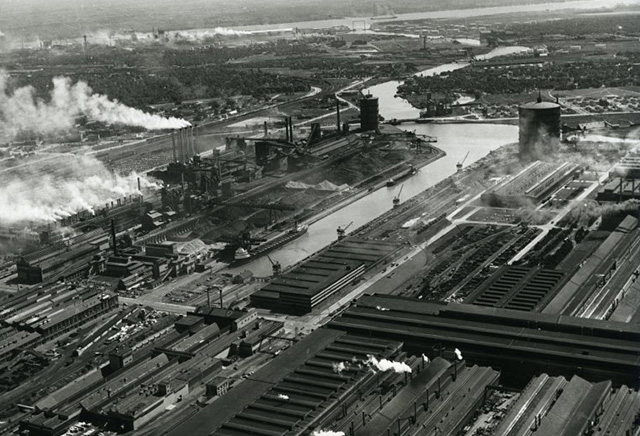
The overview that follows was produced in 2008 by MCNHA and the Detroit Riverfront Conservancy as part of a Detroit River Tour.
An Introduction to the Rouge
Henry Ford began buying the property that was to become the Rouge in 1915, acquiring a 2,000-acre stretch of bottomland along the Rouge River. The Rouge River property still was not earmarked for any particular use and Ford had even considered turning the land into a large bird sanctuary.
That changed near the end of World War I, when Undersecretary of the Navy Franklin D. Roosevelt engaged Henry Ford to build boats. In 1917, a three-story structure, Building B, was constructed for the purpose of building Eagle Boats, warships intended to hunt down German submarines. Although the war ended before the Eagle Boats ever saw combat, the effort did allow Ford to widen the Rouge River substantially, thereby raising the possibility of bringing ore boats up the river.
 Eagle Boat #59 prior to launch, produced in a record 10 days (1919)
Eagle Boat #59 prior to launch, produced in a record 10 days (1919)
Because Henry Ford was determined to be independent of suppliers, he developed the Rouge into an almost self-sufficient and self-contained industrial city. Construction began on April 1, 1917 and when it was completed in 1928, it had become the largest integrated factory in the world. Measuring 1 ½ miles wide by 1 mile long, the complex included 93 buildings with nearly 16 million square feet of factory floor space. Detroit architect Albert Kahn designed most of the complex.
With its own docks in the dredged Rouge River, 100 miles of interior railroad track, 27 miles of conveyors, 53,000 machine tools and tens of thousands of employees, the Rouge was able to turn raw materials into running vehicles within this single complex.
 Rouge Steel Rolling Mill (1920s)
Rouge Steel Rolling Mill (1920s)
The Rouge also included a blast furnace, steel mill, a glass plant, cement plant, and byproducts plant which produced petroleum products, such as paints, fertilizers, and charcoal. A massive power plant produced enough electricity to light a city the size of nearby Detroit, and a soybean conversion plant turned soybeans into plastic auto parts.
The company’s own iron ore mines in northern Michigan and Minnesota supplied the Rouge as did its Kentucky and West Virginia coal mines. Raw materials were brought in on Ford-owned railroad lines and on Ford ships to be processed at the Rouge mills. Ford established his own lumber operation in northern Michigan to provide wood used in car bodies, and a rubber plantation in Brazil for tire production.
 Rouge Docks (1930)
Rouge Docks (1930)
The first land vehicles actually assembled in the Rouge were not cars but farm tractors. No sooner had Henry Ford achieved low-cost transportation with the Model T than he set his sights on doing the same for the world’s farmers. In 1921, production of the world's first mass-produced tractor, the Fordson, was transferred from the original Dearborn plant to the Rouge.
 Rouge Assembly Line (1920s)
Rouge Assembly Line (1920s)
The Rouge achieved the distinction of automotive "ore to assembly" in 1927 with the long-awaited introduction of the Model A. During the late 1920s and early 1930s the Ford Rouge plant became the largest industrial complex in the world, as well as the most advanced, architecturally and technically. It was a city without residents. During the 1930s, more than 100,000 people worked at the Rouge. To accommodate them required a multi-station fire department, a police force, a fully staffed hospital and a maintenance crew 5,000 strong. One new car rolled off the line every 49 seconds. Each day, workers smelted more than 1,500 tons of iron and made 500 tons of glass, and every month 3,500 mop heads had to be replaced to keep the complex clean.
 Rouge Complex (1950)
Rouge Complex (1950)
It is anticipated that the Guide will, in the months to come, build upon the above discussion by:
Exploring, in more detail, the Rouge’s 1920s technological advances and how it was re-imagined by 2003 as a model of sustainable manufacturing and environmental sensibilities.
Highlighting the campaign, on the part of the United Auto Workers, to overcome fierce resistance to secure union recognition in 1941.
Documenting how African American workers gained entry into the industry in significant numbers and figured prominently in the UAW organizing efforts of the early ‘40s, while tracing Local 600’s emergence as a leading force in the modern civil rights movement.
Click to view:
Articles
Henry Ford’s Rouge, an introductory profile from The Henry Ford Museum’s website
Ford's River Rouge Plant Celebrates a Century of Nonstop Production, Andrew Wendler’s 2018 Car and Driver magazine article
Videos & Documentaries
Ford Rouge Factory Tour, this 2017 Henry Ford’s Innovation Nation with Mo Rocca CBS broadcast highlights the F150 truck assembly operation (4 minutes)
The Ford Rouge Plant Story, this 2003 Ford Motor Company video provides an overview of the Rouge’s early history and introduces the effort to transform it into a cutting edge manufacturing center that was launched in 1999 (7 minutes)
The Rouge, this 1998 WDIV-TV Kingsberry Productions comprehensive documentary focuses on the Rouge’s early years and the emergence of the UAW. This link allows it to be downloaded from the University of Michigan Library’s Deep Blue information system (1 Hour).
The Ford Rouge Plant: A Film Story of Men, Methods & Motor Cars, this 1941 Ford Motor Company documentary is narrated by veteran broadcaster Lowell Thomas and features footage highlighting its basic steel and V-8 engine manufacturing operations. (20 minutes)
PHOTO CREDITS
Detroit Historical Society
Power Plant / Eagle Boat / Ore Docks / Rolling Mill / Assembly Line / Aerial view



